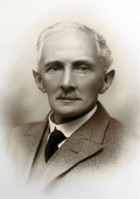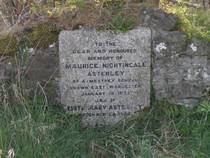__Maurice Nightingale Asterley (Sir)
1863 - 1935

Maurice Nightingale Asterley
‘Sir’ was teaching at Lucton School when he met ‘Tief’ (Edith Mary Coates) who was living at Eyton House. They married in 1905.
He taught at Lucton for 17 years, where he was a popular member of staff. "The Luctonian" Magazine of 1902 (the first edition, held in the Hereford Record Office Ref BD13/161) mentions that his testimonial was well supported, and it seems he was an enthusiastic cricket player, often turning out for the Lucton team.
I remember ‘Sir’s wonderful dark coloured cricket bat and being taught to ‘quarter’ the long grass outside the playing pitch in order to find possible lost cricket balls. I still do the same when playing golf! Alfred Morcom (1919-1924) (1990 magazine)
He taught at Lucton for 17 years, where he was a popular member of staff. "The Luctonian" Magazine of 1902 (the first edition, held in the Hereford Record Office Ref BD13/161) mentions that his testimonial was well supported, and it seems he was an enthusiastic cricket player, often turning out for the Lucton team.
I remember ‘Sir’s wonderful dark coloured cricket bat and being taught to ‘quarter’ the long grass outside the playing pitch in order to find possible lost cricket balls. I still do the same when playing golf! Alfred Morcom (1919-1924) (1990 magazine)
"The Luctonian" also records that he was leaving to start a school in Geneva. It is not clear why this did not happen, but in 1904 ‘Sir’ founded Birkdale School in Sheffield, where a house is still called Asterley House. In 1909 he sold Birkdale to a Mr Griffith, and started Aymestrey House in Worcester Road, Malvern Link. Initially there were 6 boys, all from Yorkshire.
|
Boys - men now - will remember what an enormous lot of work Sir did in the Malvern days - teaching the whole of the school hours - taking walks very often, and grand games of tracking on the hills and in the Cowleigh Woods. He also coached games and frequently took part in them. No one could galvanize a rather apathetic game of cricket like he could: with lively hitting and energetic backing up, boys were helped to make far more runs than they had ever dreamed possible, and no one was ever allowed to grouse about a result.
He was very proud of the boys and loved to see them do well in anything, but he had the greatest sympathy and patience with boys who were not quick, and would explain things again and again, till they were really understood. (Easter 1935 magazine) |
He was a delightful man, a wonderful naturalist, a great headmaster and he had a rare understanding of boys. His concern for us was, of course, that we should absorb and retain the knowledge necessary to pass the Common Entrance. But his far greater concern for us as people, that we should learn to behave. Nigel Blair-Oliphant (1920-1925) (1983 magazine) |
In the summer holidays he would cycle to North Wales with Tief’s nephews, Joseph and John Eyton Coates. Joseph Coates was amused that Dan always called his father ‘Sir’ because this was what everyone else called him.
|
Joseph Coates (1909-1914) |
_
My uncle was, I think, a very good teacher; and I have since
found that the basic methods of arithmetic he taught me are now considered to
be the most suitable as a logical foundation.
Also he kept up our interest in general knowledge, and at any moment, a
lesson would diverge into such subjects as astronomy or polar exploration.
|
_‘Sir’s’ birthday on 8 November was often celebrated with a tea-party.
In 1930 there was “A most enjoyable entertainment” including songs,
charades and fireworks. One year he was given 5 trees which were
planted in the grounds. In 1931 there were performances in the
Billiard Room.

Headstone in Eyton Churchyard
At some point he acquired the nickname ‘Baisey’. Both Oliver Philpot (1925-1927), whose account of his time at Aymestrey can be found in the magazine of Spring 1959, and George Marriott (1928-1934) remember this nickname being used. Douglas Birks (1927-1933) recalled "lying under the front lawn oak while 'Baize' read Nigel Loring to us of a summer evening" (1989 magazine)
Sir died in early 1935, and is buried next to Tief in Eyton Churchyard.
Sir died in early 1935, and is buried next to Tief in Eyton Churchyard.